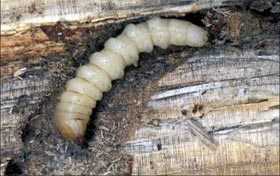Nutrition
The common name of Monochamus
notatus is the northeastern pine sawyer beetle. This name is
relevant in that pines or coniferous trees play an important
role in not only the life cycle of the beetle, but also in its
diet. Females deposit eggs into small slits they have chewed in
a form of coniferous wood. Most often, the eggs are laid in
dead, dying, or decaying wood. When the larvae emerge, they
immediately begin feeding below the bark’s surface. Young larvae
will feed on inner bark, cambium, and outer sapwood (Resh and
Carde 2003). This
feeding results in the formations of surface galleries. These
galleries are filled with saw dust and other debris left behind
during the feeding process. As a larva matures, it begins
boring back to the surface of the wood. It will chew through the
wood’s surface and emerge as a full grown adult. The adults
follow a similar diet to the larvae, but the adult is not
limited to a single piece of wood. Adults will eat the bark of
healthy pines, but often they return to dead or dying pines to
feed, mate, and lay eggs. The beetles have special digestive
enzymes in their gut which aid in the breaking down of these
materials. Final digestion of all nutrients is carried out in
the midgut cell surface (Resh and Carde 2003). Additionally, northeastern
pine sawyer beetles have an open circulatory system. This allows
them to transport food, nutrients, and water around its body (Resh
and Carde
2003).
important
role in not only the life cycle of the beetle, but also in its
diet. Females deposit eggs into small slits they have chewed in
a form of coniferous wood. Most often, the eggs are laid in
dead, dying, or decaying wood. When the larvae emerge, they
immediately begin feeding below the bark’s surface. Young larvae
will feed on inner bark, cambium, and outer sapwood (Resh and
Carde 2003). This
feeding results in the formations of surface galleries. These
galleries are filled with saw dust and other debris left behind
during the feeding process. As a larva matures, it begins
boring back to the surface of the wood. It will chew through the
wood’s surface and emerge as a full grown adult. The adults
follow a similar diet to the larvae, but the adult is not
limited to a single piece of wood. Adults will eat the bark of
healthy pines, but often they return to dead or dying pines to
feed, mate, and lay eggs. The beetles have special digestive
enzymes in their gut which aid in the breaking down of these
materials. Final digestion of all nutrients is carried out in
the midgut cell surface (Resh and Carde 2003). Additionally, northeastern
pine sawyer beetles have an open circulatory system. This allows
them to transport food, nutrients, and water around its body (Resh
and Carde
2003).
Photo Credit: Dr. Jim Appleby, University of
Illinois
Location:
United States Department of Agriculture